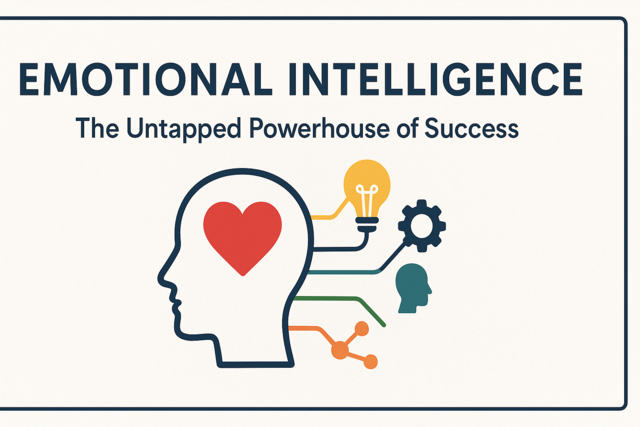Another of the most popular models of Emotional Intelligence is that of the Mixed Model. Developed by Daniel Goleman, this model of Emotional Intelligence is heavily focused on defining Emotional Intelligence using a vast array of skills and competencies that affect leadership performance. Thus, the Mixed Model is often used in a corporate or other professional setting to train and evaluate management potential and skills. The Mixed Model outlines five essential Emotional Intelligence constructs:
- Self-awareness - Interpreted as recognizing one's own emotions, strengths and weaknesses, goals, motivations, and values. This element of the Mixed Model also includes the ability to recognize one's impact on others, and using a certain level of intuition to guide their decisions regarding how they alter the emotions of others.
- Self-regulation - This involves recognizing one's own negative or disruptive emotions and impulses and controlling or redirecting them to a productive or positive purpose or feeling. This element also includes the individual's capacity to adapt to changing circumstances.
- Social scale - This construct simply utilizes the first two elements in such a way as to manage relationships with those around you to move people in the direction you want them to go. In simple terms, this might include a manager finding a new way to motivate an employee or someone communicating their positive attributes on a first date to secure a second date.
- Empathy - Though sometimes confused with sympathy, empathy is actually an entirely different process. In sympathy, one typically feels sorry or badly regarding a challenge or problem another person is having. When a person practices empathy, they are able to personally identify with the challenges of another, and to consider the feelings of others when making decisions. Empathy often serves pragmatic and emotional purposes.
- Motivation - In the Mixed Model of Emotional Intelligence, it is theorized that a person with a high EQ will be able to successfully motivate themselves to achieve their goals. Essentially, this accounts not only for goals with pragmatic results, (such as a job promotion), but also achievement for the sake of achievement. The Mixed Model requires an individual with high Emotional Intelligence to seek success for no purpose other than because it is success.
The Mixed Model is very popular among executives and corporate offices that seek to use the theories of Emotional Intelligence to maximize their human resources. Typically, a management consulting company will perform a series of evaluations of staff members or potential hires based on the Mixed Models set of values. The company may then make suggestions or recommendations regarding staff, or may train staff directly to strengthen their EQ. Measurement of Emotional Intelligence according to the Mixed Model Theory falls into a somewhat gray area. When possible, it is recommended for a self-reporting questionnaire to be accompanied by a questionnaire regarding at the same person that is completed by someone else, such as an employer or supervisor. While this measure of testing is still not a preferred method for scientific study, it is generally accepted to be a better option than self reporting alone. However, because the Mixed Model is used so often in a business setting, where a co-worker or supervisor is typically not objective -- or if a person is being considered for a position and there is not anyone to complete a secondary questionnaire -- the test can be performed by self report alone. Nevertheless, this, of course, makes the test less scientifically valid.
The Mixed Model has received some criticism from scholars who find it to be less scientifically proven, and more akin to pop psychology. While "pop psychology" typically has the connotation of something negative, this is not always the case. Generally, pop psychology is criticized for being too popular to maintain its scientific legitimacy, or that it is being used incorrectly due to its popularity. While there are many concerns regarding the validity of EI as pop psychology, it likewise should not be assumed that because something is widely recognized or respected, it is necessarily lacking scientific support. Rather, it is important to ensure that delivery of information regarding EQ to an individual should be done by a professional; a layperson administering a self report with the goal of tracking aspects of the Mixed Model theory of Emotional Intelligence is inappropriate and a misuse of legitimate psychological research and theory.
When comparing the Ability Model with the Mixed Model, proponents of the Ability Model generally claim that the primary error utilized in the Mixed Model is that it includes aspects of personality that are not inherently based in either emotion or intelligence, and therefore, is not appropriately measuring Emotional Intelligence. Proponents of the Ability Model believe that if you include these other aspects of personality, rather than simply measuring something relating directly to emotion or intelligence (or both), it will provide inaccurate data and results among the legitimate measures of actual Emotional Intelligence.
The Bar-On Model of Emotional Social Intelligence and the Genos Model
,
The Bar-On Model of Emotional Social Intelligence draws on the assumption, or theory, that an individual's social abilities are separate from their Emotional Intelligence skills, but are just as critical for a person to achieve the goals outlined in other models of Emotional Intelligence. Put simply, the Bar-On Model distinguishes the ability to affect the emotions and behaviors of others (social skills), from the ability to recognize and regulate one's own emotions (Emotional Intelligence). The Bar-On Model takes a more holistic approach to defining Emotional Intelligence, whereby it includes an individual understanding oneself, understanding others, and relating well to people -- but also to adapting and coping with environmental demands and stressors.
Rather than necessarily defining specific attributes as being superior to others when it comes to Emotional Intelligence, Bar-On believes that those with high EQs are more capable, through whatever means, of dealing with emotional challenges and environmental demands and pressures. In this way, the theory becomes less about any particular skill being more worthwhile, or any characteristic being superior, but rather looks at it as defined by the individual's ability to meet their own needs. Nevertheless, the model does still posit that people with high EQs will be more successful in a number of contexts. While some may argue that this firmly places the Bar-On Model with other models that define some type of emotional superiority, proponents believe the success that comes to an individual with a high EQ (according to the Bar-On Model), does so not because they are equipped with any particular single characteristic; instead, that individual achieves success according to their own standards, because of their ability to cope with environmental stress and personal challenges.
The Bar-On Model does propose that those with lower EQs are more likely to struggle with impulse control, stress tolerance, problem solving, and so on. Essentially, the Bar-On Model believes that cognitive intelligence and Emotional Intelligence contribute equally to an individual's overall intelligence, which does offer some indication of an individual's potential to succeed in life.
It's easy to see how this approach from the Genos Model is attractive to those in the business community. The unproductive characteristics identified within this model are certainly more likely to cause performance problems at a person's place of employment; the Genos Model essentially advocates that it does not need to address personality characteristics or other psychological aspects, because it addresses issues of job performance directly.
Measurement of an individual's EQ according to the Genos Model consists of a 70-question assessment test that is ideally taken by multiple raters, regarding the same individual, to minimize any negative aspects resulting from using only a self report. Consulting companies that use the Genos Model when conducting evaluations of current employees and managers, are likely to use an individual's self report, along with assessments created by a supervisor and co-workers. In fact, assessments may be completed by clients or suppliers when appropriate. However, there is a self-assessment-only version of the Genos Emotional Intelligence Development Assessment; this is used most often in situations where an employee is new, or is being considered to be hired, and therefore not subject to multi-rater assessments. The assessment has been evaluated to show meaningful correlations with variables such as leadership performance, job engagement, and job satisfaction. It also has extensive international benchmarks and can be mapped to frameworks that identified other leadership and capability assessments.
Although the Genos Model has been specifically developed for use in the workplace, proponents do advocate that the results obtained from the assessment can be useful to the individual in virtually all aspects of their lives. Sample reports include detailed evaluations of an individual's strengths and weaknesses, suggested implementations of how to develop productive values from any unproductive aspects of the individual, and so on. They also contain information regarding the number of raters whose assessments were included in the results, how closely those assessments related to the self report, and how closely those assessments correlated with each other.
This ends the outlines of each of the main theories of Emotional Intelligence. Obviously, there's a wide variance between different theories relating to what Emotional Intelligence truly is, how best to measure it, and how to use that information to promote change in an individual (and if promoting change in the individual is even desirable). For all of these differences, it is important to remember that at their core, they all hold certain aspects of Emotional Intelligence: that an individual's level of social intelligence includes their ability to recognize and maintain their own emotions, as well as recognize and respect that others have emotions, as well.























